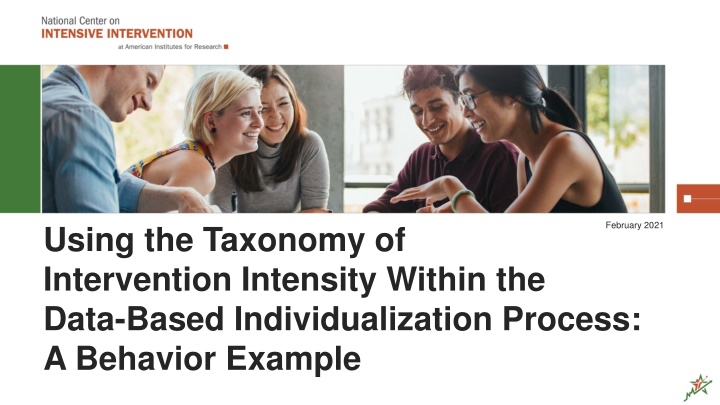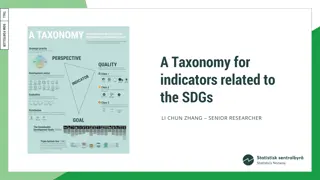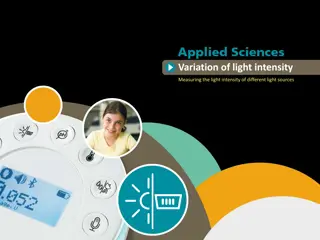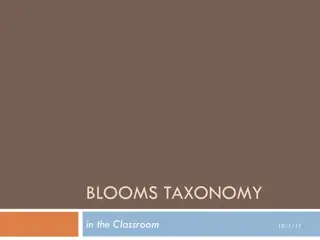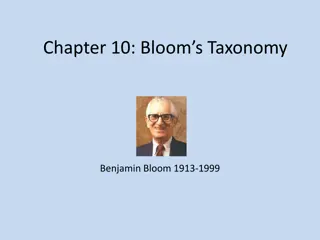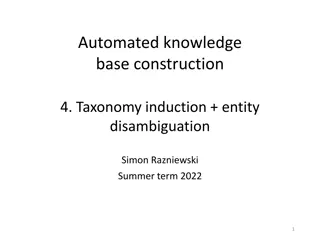Taxonomy of Intervention Intensity: Behavioral Example
Session on the Taxonomy of Intervention Intensity within the Data-Based Individualization process through a behavior example. Topics include defining dimensions, selecting programs, intensifying interventions, and accessing resources.
Download Presentation

Please find below an Image/Link to download the presentation.
The content on the website is provided AS IS for your information and personal use only. It may not be sold, licensed, or shared on other websites without obtaining consent from the author.If you encounter any issues during the download, it is possible that the publisher has removed the file from their server.
You are allowed to download the files provided on this website for personal or commercial use, subject to the condition that they are used lawfully. All files are the property of their respective owners.
The content on the website is provided AS IS for your information and personal use only. It may not be sold, licensed, or shared on other websites without obtaining consent from the author.
E N D
Presentation Transcript
February 2021 Using the Taxonomy of Intervention Intensity Within the Data-Based Individualization Process: A Behavior Example
Learner Outcomes At the end of the session, participants will be able to: Define the dimensions of the Taxonomy of Intervention Intensity and explain how they support the data-based individualization (DBI) process. Apply the dimensions of the taxonomy to evaluate or select a validated behavior intervention program. Use the taxonomy to intensify a behavior intervention for a student who is not responsive. Access existing resources to support evaluation and intensification. 2
Agenda 1. Review: Behavior basics and the DBI process 2. Go deep: The taxonomy dimensions in behavior Academic Support Strength Dosage Alignment Strength Dosage Alignment Transfer Comprehensiveness An image of a bullseye An image of a teacher and three students playing. 3. Case example: Using the Taxonomy of Intervention Intensity to support the DBI process to address behavior 3
Behavior Terminology: A Quick Review 4
Three-Term Contingency A B C Behavior Consequence Antecedent 5
Reinforcement Following a behavior, something is added or moved from the environment, and that behavior increases in the future. 6
Function of Behavior Functions of behavior include access to or escape from: Attention Tangibles, activities Demands, tasks Sensory stimulation Function plays a role in selecting and adapting behavioral interventions for students with a history of challenging behavior. 7
Data-Based Individualization 8
Activity: Taxonomy K-W-L What Does It Help Me KNOW? What More Do I WANT to Know? How Will I LEARN More? Handout 9
Data-Based Individualization A systematic method for using data to determine when and how to provide more intensive intervention An ongoing process not a single intervention Intended for students with severe and persistent learning and behavioral needs 10
Five DBI Steps 1. Validated intervention program, delivered with fidelity 2. Progress monitoring 3. Informal diagnostic assessment 4. Adaptation to validated intervention 5. Continued progress monitoring, with adaptations occurring whenever needed to ensure adequate progress 11
Using the Taxonomy of Intervention Intensity Within the DBI Process Evaluate current interventions. Select a new intervention. Intensify the intervention. 12
What Are Validated Interventions? Standardized, evidence-based interventions designed for students who are at risk Also known as . . . Tier 2 or supplemental interventions Small-group interventions 13
Activity: Current Intervention Brainstorm 1. What behavior interventions are you currently using with students in your classroom? (Or what interventions have you used in the past)? 2. How do you select interventions? 3. How do you decide how and when to make adaptations to an intervention for a particular student? Handout 14
When Selecting or Evaluating a Validated Intervention, Where Should We Start? Readily available interventions: What do you already have in place? Do you have educator buy-in? 15
When Selecting or Evaluating a Validated Intervention, What Should We Consider? Does evidence suggest that the intervention is expected to lead to improved outcomes (strength)? Will the group size, duration, and frequency provide sufficient opportunities to respond (dosage)? Does the intervention match the student s identified needs (alignment)? Does the intervention assist the student in generalizing the learned skills to general education or other tasks (attention to transfer)? Does the intervention include elements of explicit instruction (comprehensiveness)? Does the student have opportunities to develop the behavior skills needed to be successful (behavioral support)? Can the intervention be easily integrated into academic instruction (academic support)? Can the intervention be individualized with a data-based process to meet student needs (individualization)? Handout 16
Taxonomy of Intervention Intensity 17
The Taxonomy of Intervention Intensity A system for describing an intervention in terms of seven dimensions, along which intensity can vary This system helps special educators and interventionists: Identify best-match validated intervention programs Formulate adjustments to boost student progress 18
Taxonomy Ratings Handout 0 1 2 3 Fails to Address Standard Addresses Standard Minimally Addresses Standard Moderately Addresses Standard Well 19
Strength 20
What Do We Mean by Strength? How well the program works for students with intensive intervention needs, sometimes expressed as a promising or effective program by a reliable source (e.g., National Center on Intensive Intervention [NCII] Tools Charts, What Works Clearinghouse [WWC]): Has this intervention been evaluated empirically using scientifically sound, rigorous methodology? If so, what is the reported standardized mean effect size for this intervention, or what does the visual analysis tell us? 21
Using Effect Sizes to Evaluate Strength A quantitative way to look at the strength of an intervention Several factors impact the effect size. The general guidelines provided below can be used as a starting point, but other factors should be considered. Strength Effect Size Small (minimum) 0.25 to 0.34 Moderate 0.35 to 0.49 Strong 0.50 or larger 22
How Important Are Effect Sizes? When available, effect sizes must be interpreted with caution. Effect sizes can be impacted by: Study conditions Content studied Study population Effect sizes are not always available. 23
Using Visual Analysis to Evaluate Strength Data for behavior interventions are often evaluated using visual analysis. Kazdin defines visual analysis as reaching a judgment about the reliability or consistency of intervention effects by visually examining graphed data (Kazdin 1982, p. 232). 24
How Can I Find Information About Strength? What Works Clearinghouse (https://ies.ed.gov/ncee/wwc/) NCII Behavior Intervention Tools Chart (https://charts.intensiveinterve ntion.org/bintervention) 25
Using WWC to Evaluate Strength 1. Visit the Institute of Education Sciences What Works Clearinghouse. 2. Select Behavior. 3. Identify interventions with purple icons that indicate positive or potentially positive evidence of effectiveness. 4. Review intervention reports to learn more about intervention and results. 26
Using the NCII Behavior Intervention Tools Chart to Evaluate Strength 27
Dosage 30
What Do We Mean by Dosage? Number of opportunities to respond (i.e., practice or demonstrate skill) Number of opportunities for positive feedback (e.g., praise, tokens, points) Number of opportunities to exchange for backup reinforcers Number of opportunities for corrective feedback 31
Why Do We Think About Opportunities to Respond? Increased opportunities is a structured approach to using an appropriate instructional pace to maximize engagement (Menzies et al., 2017). Higher rates of reinforcement are predictive of higher rates of responding (Martens, 2018). 32
How Would You Rate the Dosage? Teacher holds daily, 20-minute social skills lessons for small groups of students (3 5 students) Lessons follow direct instruction format: Teacher models the skill of the day Teacher and students practice skill together Students practice in pairs, with feedback from the teacher 33
Turn and Talk To what extent do these situations impact the dosage intensity in your school or district? Instructional disruptions (testing, special events, intervention session cut short) Larger than designed group size Fewer sessions than intended Lack of student engagement 35
Alignment 36
What Do We Mean by Alignment? Intervention addresses schoolwide expectations Intervention addresses classroom and teacher expectations Intervention addresses target student s skill deficits Rewards are matched to target student s preferences and/or function(s) of behavior Intervention can easily be adapted to address various functions of behavior Intervention does not address extraneous skills 37
Why Do We Think About Alignment? Streamlined procedures may improve implementer fidelity and student outcomes. There should be a match between intervention and targeted skill deficits. 38
In Other Words, Interventions Should Be . . . Aligned with expectations and priorities of all stakeholders, including school at large, as well as classroom staff Targeted to student s individual needs related to function and preferences: Rely on data collected as part of the progress monitoring and functional behavioral assessment (FBA) processes Efficient: How easily can the platform be adjusted? Is there any wasted effort? 39
Understanding Student Needs Related to Function and Preferences 40
What Do We Mean by Attention to Transfer? Intervention emphasizes how and when a student uses skills across contexts and situations; it includes opportunities to practice using skills across contexts and situations Intervention program s reinforcement for use of skills across contexts and situations 42
Rating Attention to Transfer: Practice Broader measures Assess outcomes that are related to the competencies or skills targeted by the program but not directly taught in the program. In the behavioral domain, if a program taught a specific skill like on-task behavior in one classroom, a broader measure would be on-task behavior in another setting. 43
What Do We Mean by Comprehensiveness? Intervention includes a plan for teaching appropriate behaviors, with adequate opportunities for practice Intervention includes plan for adjusting antecedent conditions to prevent problem behavior Intervention includes plan for reinforcing appropriate behavior Intervention includes plan for minimizing reinforcement for problem behavior Intervention includes a plan for fading supports; supports can easily be faded Fidelity of implementation can be checked or monitored easily Intervention works in conjunction with related services Intervention includes plan for communicating with parents 46
Plan for Teaching Appropriate Behaviors Focus of teaching is on a replacement behavior 47
Plan for Adjusting Antecedent Conditions Adjust antecedent events based on a function of behavior 48
Example: Choice as an Antecedent Intervention Does the component of the intervention address antecedent conditions that may contribute to problem behavior? An FBA indicated . . . Problem behavior occurs reliably during writing assignments Escape function Student reports hating writing because it makes his hand hurt As part of a larger intervention package, the teacher will offer the student a choice of modality for writing during language arts block (e.g., handwrite versus type) 49
Plan for Reinforcing Appropriate Behavior Consider consequences for appropriate behavior: Does the plan specify consequence(s) to follow appropriate behaviors some of the time or all the time? Are those consequences likely to increase the future probability of the appropriate behaviors? 50
Plan for Minimizing Reinforcement of Problem Behavior Does the plan specify what should be done when problem behavior occurs? Are these consequences unlikely to increase the future probability of problem behavior? 51
